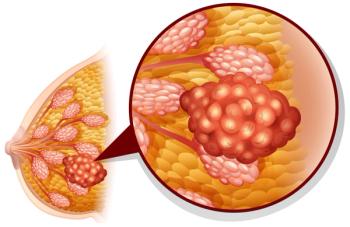
- ONCOLOGY Vol 11 No 2
- Volume 11
- Issue 2
Clinical Relevance of Laboratory and Animal Data on Tamoxifen
Tamoxifen is being evaluated in clinical trials as a preventive agent in women at high risk for breast cancer. This new, potentially long-term therapeutic role has generated some concerns regarding safety, based on the results of
ABSTRACT: Tamoxifen is being evaluated in clinical trialsas a preventive agent in women at high risk for breast cancer. This new,potentially long-term therapeutic role has generated some concerns regardingsafety, based on the results of animal studies that demonstrated an increasedincidence of liver cancer in rats and the formation of DNA adducts. However,direct extrapolation of data from rats to risk estimates in women doesnot appear to be appropriate. Studies have shown that there are substantialspecies-related differences in activation and detoxication of tamoxifenthat directly affect the formation of DNA adducts. This major species differencein DNA adduct formation appears to be the result of differences in metabolicactivation and detoxication; humans form much less of the electrophilicmetabolites that bind to DNA and rapidly detoxify those that are formed.[ONCOLOGY 11(Suppl 1):39-44, 1997]
Introduction
Tamoxifen (Nolvadex) is a nonsteroidal antiestrogen that has becomethe agent of choice in the medical management of breast cancer.[1-3] Followingits introduction in the 1970s for the treatment of metastatic breast cancerin postmenopausal women, the therapeutic role of tamoxifen has grown toinclude initial endocrine therapy for estrogen receptor (ER)-positive disseminatedbreast cancer in premenopausal women, systemic adjuvant for early breastcancer in both premenopausal and postmenopausal women, and therapeuticagent for the treatment of metastatic breast cancer in men.[1-3] In patientswith advanced breast cancer, complete and partial responses have been observedin 30% to 40% of unselected patients, 50% of patients with ER-positivetumors, and 60% to 70% of patients with both ER and progesterone receptor(PR)-positive tumors.[1-3]
Tamoxifen has been consistently associated with improved disease-freesurvival and overall survival in patients with early breast cancer in anumber of adjuvant therapy trials.[2-5] In addition, systemic adjuvanttherapy with tamoxifen has been demonstrated to reduce the risk of developingcontralateral breast cancer by 39% to 40%.[2,3] A trend toward decreasedincidence of non-breast second primary malignancies in women receivingadjuvant tamoxifen therapy for early stage breast cancer has also beenobserved.[2] Other benefits associated with tamoxifen include a possiblecardioprotective estrogen-like effect, as well as a positive effect onbone mineral density, in postmenopausal women.[3,6,7] In addition, tamoxifenhas eliminated the need for, and morbidity associated with, such surgicalprocedures as hypophysectomy, adrenalectomy, and possibly oophorectomyin premenopausal women with breast cancer.[2]
Recently, several clinical trials were initiated to evaluate tamoxifenas a preventive agent in women at high risk for breast cancer.[2,8,9] Onlypreliminary data are currently available from these ongoing trials.
Clinical observations have suggested that tamoxifen administration isassociated with a slightly increased risk of endometrial carcinoma, witha rate of detection of 0.2% to 0.3% per year compared with 0.1% in breastcancer patients not receiving tamoxifen. [10,11] The increases in endometrialcancer are similar to those observed with hormone replacement therapy.Tamoxifen therapy does not appear to be associated with an increased riskfor the development of high-grade endometrial cancers with a poor prognosis,and the general consensus of the medical community is that in patientswith breast cancer, the clinical benefits of tamoxifen outweigh the riskof endometrial carcinoma.[2,10] However, the risk of tamoxifen administrationto healthy women without breast cancer has generated some concern in themedical community.
The debate about the use of tamoxifen as a chemoprotective agent hasbeen fueled by animal and laboratory data demonstrating an associationof tamoxifen administration with the formation of DNA adducts[12-20] andhepatocellular carcinomas in rats.[10] In contrast to the rat data, epidemiologicobservations in humans do not suggest an increased risk for liver tumorsin patients treated with tamoxifen.[21] This review summarizes human- andanimal-derived laboratory data related to the hepatocarcinogenic potentialof tamoxifen therapy and discusses the clinical relevance of these findings,including the formation of tamoxifen-specific DNA adducts.
Carcinogenesis is known to be a multistage process involving multiplegenetic alterations in key genes involved in cell regulation and growth.[22] The simplest model of carcinogenesis involves two stages: initiationand promotion. Initiation happens when a mutation occurs in one of thesecritical genes that results in the initiated cell having a growth advantageover its normal counterpart. Promotion is best described as the clonalexpansion of an initiated cell. In most cases, this model is overly simplistic;the process actually repeats itself two or more times. The clonal expansionof the initiated cell population increases the probability of a secondmutation, and this often leads to further clonal expansion of its progeny.As these additional genetic alterations occur, a lesion progresses froman initiated cell to preneoplastic lesion to benign tumor to malignantneoplasm to metastasis.
One of the most common causes of genetic mutations is the binding ofelectrophilic chemicals to nucleic acid bases that make up DNA.[23,24]These altered nucleotides are referred to as DNA adducts. The electrophilesmay be present due to exposure to environmental chemicals such as thosein tobacco smoke or drugs, or even endogenous chemicals that result fromnormal cellular metabolism. For example, the normal steady-state levelof the DNA adduct 8-hydroxydeoxyguanosine in the rat is about one adductper 105 bases or 90,000 adducts per cell.[12] This amount ofoxidative damage has been theorized to be a major factor in the aging processand age-associated diseases such as cancer.
The effect of DNA adduct formation is lessened by DNA repair that occursthrough a complex set of pathways and that can restore damaged DNA to itsoriginal normal state. Ultimately, the number of DNA adducts present ina cell at the time that a cell undergoes DNA replication for cell divisionis ultimately associated with the probability of mutation, with the chanceof mutation increasing as the number of DNA adducts per cell increases.[23,24]
Species Differences in Metabolism
Various laboratory studies have demonstrated that tamoxifen can be biotransformedin the liver to a number of metabolites that could potentially lead tothe formation of DNA adducts; the metabolites include alpha-hydroxytamoxifen,the 3,4-epoxide and 3',4'-epoxide metabolites of tamoxifen, and 4-hydroxytamoxifen(through conversion to 4-hydroxytamoxifen methide quinone).[13-19] In rathepatocytes, alpha-hydroxytamoxifen has been demonstrated to have a highDNA-binding affinity, 25- to 49-fold greater than that of its parent compound.[15]
Tamoxifen is metabolized more slowly by human microsomes than by thoseof rats, and both quantitative and qualitative differences in the formationof tamoxifen metabolites exist among rats, mice, and humans (Table1).[25-27] For example, the concentration of alpha-hydroxytamoxifenproduced by hepatocytes incubated with tamoxifen has been demonstratedto be about 50-fold greater in rats or mice compared with humans.[25] Thisis of special note since alpha-hydroxytamoxifen appears to be the majormetabolite leading to the formation of DNA adducts in rats.[14,15,25] Inaddition, the 3',4'-epoxy metabolite and its hydrolyzed metabolite 3',4'-dihydrodihydroxytamoxifenhave been identified in rat liver microsomal systems following administrationof tamoxifen, but have not been not identified in microsomal systems frommice or humans.[27] Only trace amounts of the 3,4-epoxy metabolite andits hydrolyzed derivative 3,4-dihydrodihydroxytamoxifen have been identifiedin a human liver microsomal system.[27]
In Vitro Studies
Human and rat liver microsomes have the enzymatic capability of activatingtamoxifen to electrophilic metabolites that can form DNA adducts. However,the quantitative relationships between the number of DNA adducts formedper unit dose of tamoxifen are several orders of magnitude lower in humancells than in cells of rats. [19,25,28-30] Large differences exist betweenthe number of tamoxifen-associated DNA adducts produced in vitro usingrat hepatocytes compared to the number formed using human hepatocytes.In a recent study, DNA adducts on the order of 18 to 90 adducts per 108nucleotides were formed when rat hepatocytes were treated with 1-10 mMtamoxifen.[25] In contrast, no adducts were detected in similarly treatedhuman hepatocytes (assay detection limit of one adduct per 1010nucleotides). Similarly, human hepatocytes treated with alpha-hydroxytamoxifenproduced 300-fold fewer DNA adducts than did rat hepatocytes.[25] Verylow numbers of DNA adducts (one adduct per 109 nucleotides)were formed by tamoxifen or toremifene (another antiestrogen) when humanor rat liver microsomes were incubated with salmon sperm DNA and 1% solutionsof the antiestrogen compound, or when human lymphocytes were incubatedwith 0.1% or 1% solutions of the antiestrogens.[31] When tamoxifen at relativelyhigh concentrations (20 to 500 mM) was incubated with endometrial tissuefrom nonexposed women, no DNA adducts were detected using a method to detecttamoxifen-specific DNA adducts.[30] DNA adduct levels on the order of 5to 30 adducts per 108 nucleotides were observed following treatmentof endometrial tissue with alpha-hydroxytamoxifen (20 to 500 mM); however,the lowest dose of alpha-hydroxytamoxifen required to produce DNA adductsrepresented a concentration 10,000 times higher than that observed in theendometrial cultures of tamoxifen-treated patients, or found circulatingin the blood of patients.[30] Incubation of 100 mM 4-hydroxytamoxifen ormetabolite E with rat uterine peroxidase or horseradish peroxidase produced4 to 55 DNA adducts per 109 nucleotides, with higher numbersof adducts being found in extracts from tamoxifen-treated rats.[32]
In Vivo Studies
A number of animal studies have demonstrated the formation of DNA adductsin the liver following the administration of high doses of tamoxifen torodents (Table 2).[18,20,31-34] The resultsof these laboratory studies indicate a dose-dependent and time-dependentrelationship between admin- istration of tamoxifen and the appear- anceof DNA adducts, as well as a species-specific effect on the number of adductsformed. Mice formed about one third the number of DNA adducts producedin rats when both species were given 45 mg/kg/day; however, mice did notdevelop liver tumors.[18,33]
Earlier studies using 32P-postlabeling techniques examinedDNA extracts from the livers of seven women with breast cancer treatedwith tamoxifen (20 or 40 mg/day for 6 to 44 months) and seven women whohad never received tamoxifen (control group). There was no significantdifference between the tamoxifen and control groups with respect to theamount of DNA damage.[28] When DNA samples from the white blood cells ofseven patients receiving adjuvant tamoxifen therapy (20-40 mg/day for threemonths to six years) and three healthy women were analyzed, no significantdifference in chromatographic profile of DNA was noted between the tamoxifenand control groups.[29] These studies must be viewed with caution, however,since the methods did not identify tamoxifen-specific DNA adducts. Morerecently, Hemminki et al identified tamoxifen-specific DNA adducts in theendometrium of 5/7 women being treated with tamoxifen, but in 0/5 womennot receiving tamoxifen.[35] The level of DNA adducts present was extremelylow, averaging 2.7 adducts per 109 nucleotides. No tamoxifen-specific DNAadducts have been reported in livers of women receiving tamoxifen. Theselevels in humans are vastly different than those observed in rat liversunder conditions that result in hepatic tumor formation, in which 30,000adducts per 109 nucleotides were present. [34]
Other Studies on the Genotoxic Potential of Tamoxifen
As part of the initial product development effort, tamoxifen was evaluatedusing a conventional battery of genotoxicity assays. Tamoxifen and itsmetabolites did not cause mutations in five strains of Salmonella typhimurium,nor was it considered to be mutagenic at the hprt locus in Chinese hamsterovary (CHO) cells. Tamoxifen (up to 250 mcg/mL) did not cause DNA damageand repair in HeLa cells. Chromosomal aberrations in cultured human lymphocyteswere not observed at tamoxifen concentrations 10 or less mcg/mL. Dose-relatedincreases in micronucleus formation were observed in human MCL-5 cells;however, these genetically engineered cells lack many phase II metabolicenzymes.[33]
Typically, the average woman with breast cancer is given less than 0.6mg/kg/day of tamoxifen for about 6% of her life span.[10] In contrast,rats in the tamoxifen carcinogenicity studies were given 5 to 45 mg/kg/dayfor about 50% of their life span, starting just after puberty.[10] Becauserodents have a much higher clearance rate for tamoxifen than do humans,much higher doses of tamoxifen must be administered to rodents than humansin order to maintain somewhat comparable plasma level of drug in the twospecies. However, the maximum tolerated doses of tamoxifen also causedthree- to six-fold increases in cell proliferation.[34] It is well knownthat sustained increases in cell proliferation strongly potentiate carcinogenicity.
A number of studies have demonstrated that in rats, high doses of tamoxifencan act as an initiator or promoter of hepatocellular carcinomas (Table3).[36-42] However, no tamoxifen-associated liver tumors have beenobserved in mice, although benign interstitial cell testicular tumors andbenign granulosa cell ovarian tumors have been associated with tamoxifenadministration.[39]
In addition, in hamsters, tamoxifen has been demonstrated to preventestrogen-associated hepatic injury and hepatocarcinogenesis.[40,41] Inhumans, tamoxifen therapy has not been associated with an increased incidenceof liver tumors, either during the current chemoprotective trials or duringthe 20-year period since its introduction.[10]
Tamoxifen therapy produces a substantial alteration in the natural historyof breast cancer, and it has become a cornerstone in its management. Thebenefits of tamoxifen therapy clearly outweigh the risks of toxicity inwomen with early or advanced breast cancer. However, controversy stillsurrounds tamoxifen's potential role as a chemoprotective agent in healthywomen at high risk for breast cancer. Realistic risk to benefit ratiosin this population cannot be determined until data from ongoing clinicalchemoprevention trials are thoroughly evaluated. With regard to concernsabout the theoretical risks related to DNA adduct formation and rat carcinogenicitydata, the following points need to be considered:
Liver tumor induction in rodents appears to be a highly species-specificform of toxicity. While tamoxifen is a liver carcinogen in the rat, itis not associated with liver tumors in mice or humans, and has a protectiveeffect in hamsters due to its antiestrogenic properties.
Human hepatocytes are far less capable of activating tamoxifen to potentialDNA-binding metabolites than either rat or mouse hepatocytes.
Human hepatocytes appear to be approximately 300-fold better able todetoxify potential tamoxifen-associated, DNA-binding metabolites than rodenthepatocytes.
While in vitro studies have demonstrated the formation of tamoxifen-associatedDNA adducts by human liver microsomes, the formation is approximately 50-foldless than that observed in rodent microsomal preparations.
DNA adducts have only been observed in cultured human cells followingexposure to nonclinically relevant concentrations of alpha-hydroxytamoxifen,but not following exposure to tamoxifen.
Tamoxifen-specific DNA adducts have not been demonstrated in liversof humans receiving tamoxifen. Only one study has identified tamoxifen-specificDNA adducts in human endometrium, and the number of adducts was ~ 1/10,000ththe amount found in rat liver.
A recent expert panel concluded that current technological capabilitiesfor detection of DNA adducts exceeds our ability to define the biologicalsignificance of adducts as it relates to health outcome. They further statedthat adduct measurements must be placed in perspective with endogenousDNA adducts, which range from one adduct per 108-105nucleotides.[43]
No increase in the incidence of liver carcinogenesis has been observedin women in the United States in the 20 years since the introduction oftamoxifen.
The results of the aforementioned studies evaluating DNA adduct formationand genotoxic potential of tamoxifen indicate important species-relateddifferences in the ability to form DNA adducts that stem from differencesin metabolic activation and detoxication. The data suggest that phase IImetabolism in human tissue is much more efficient at detoxication of thefew electrophilic tamoxifen metabolites produced. Broad clinical experienceand careful examination of laboratory evidence suggest that tamoxifen-specificDNA adducts and liver carcinomas are species-specific laboratory phenomenathat are not directly applicable to clinical human use. Clearly, whilethe risk/benefit assessment for tamoxifen shows a strong benefit in patientswith breast cancer. Benefit risk evaluations have not been completed indifferent groups of high-risk patients enrolled in the prevention studies.Clearly, while the risk/benefit assessment for tamoxifen shows a strongrationale for treatment, it is necessary to continue to monitor patientpopulations for potential cancer risks.
References:
1. Kimmick G, Muss HB: Current status of endocrine therapy for metastaticbreast cancer. Oncology 9:877-890, 1995.
2. Jaiyesimi IA, Buzdar AU, Decker DA, et al: Use of tamoxifen for breastcancer: Twenty-eight years later. J Clin Oncol 13:513-529, 1995.
3. Robinson E, Kimmick GG, Muss HB: Tamoxifen in postmenopausal women:A safety perspective. Drugs & Aging 8:329-337, 1996.
4. Fisher B, Costantino J, Redmond C, et al: A randomized clinical trialevaluating tamoxifen in the treatment of patients with node-negative breastcancer who have estrogen-receptor-positive tumors. N Engl J Med 320:479-484,1989.
5. Nolvadex Adjuvant Trial Organization: Controlled trial of tamoxifenas single adjuvant agent in management of early breast cancer. Lancet 1:836-840,1985.
6. McDonald CC, Stewart HJ, Scottish Breast Cancer Committee: Fatalmyocardial infarction in the Scottish adjuvant tamoxifen trial. Br MedJ 303:435-437, 1991.
7. Rutqvist LE, Mattsson A, Stockholm Breast Cancer Study Group: Cardiacand thromboembolic morbidity among postmenopausal women with early stagebreast cancer in a randomized trial of adjuvant tamoxifen. J Natl CancerInst 85:1398-1406, 1993.
8. Powles TJ, Jones AL, Ashley SE, et al: The Royal Marsden Hospitalpilot tamoxifen chemoprevention trial. Breast Cancer Res Treat 31:73-83,1994.
9. Fisher B, Redmond CK: A clinical trial to determine the worth oftamoxifen for preventing breast cancer. National Surgical Adjuvant Breastand Bowel Project (NSABP) Protocol P-1, 1991.
10. Bilimoria MM, Assikis VJ, Jordan VC: Should adjuvant tamoxifen therapybe stopped at 5 years? Cancer J Sci Am 2:140-150, 1996.
11. Fisher B, Costantino JP, Redmond CK, et al: Endometrial cancer intamoxifen-treated breast cancer patients: findings from the National SurgicalAdjuvant Breast and Bowel Project (NSABP) B-14. J Natl Cancer Inst 86:527-537,1994.
12. Ames BN, Gold LS: Chemical carcinogenesis: too many rodent carcinogens?Proc Natl Acad Sci 87:7772-7776, 1990.
13. Cunningham A, Klopman G, Rosenkranz HS: A study of the structuralbasis of the carcinogenicity of tamoxifen, toremifene and their metabolites.Mutation Res 349:85-94, 1996.
14. Osborne MR, Hewer A, Hardcastle IR, et al: Identification of themajor tamoxifen-deoxyguanosine adduct formed in liver DNA of rats treatedwith tamoxifen. Cancer Res 56:66-71, 1996.
15. Phillips DH, Carmichael PL, Hewer A, et al: a-hydroxytamoxifen,a metabolite of tamoxifen with exceptionally high DNA binding activityin rat hepatocytes. Cancer Res 54:5518-5522, 1994.
16. Moorthy B, Sriram P, Pathak DN, et al: Tamoxifen metabolic activation:comparison of DNA adducts formed by microsomal activation and chemicalactivation of tamoxifen and 4-hydroxytamoxifen with DNA adducts formedin vivo. Cancer Res 56:53-57, 1996.
17. Potter GA, McCague R, Jarman M, et al: A mechanistic hypothesisfor DNA adduct formation by tamoxifen following hepatic metabolism. Carcinogenesis15:439-442, 1994.
18. Randerath K, Moorthy B, Mabon N, et al: Tamoxifen: Evidence by 32P-postlabelingand use of metabolic inhibitors for two distinct pathways leading to mousehepatic DNA formation and identification of 4-hydroxytamoxifen as a proximatemetabolite. Carcinogenesis 15:2087-2094, 1994.
19. Pathak DN, Bodell WJ: DNA adduct formation by tamoxifen with ratand human liver microsomal activating systems. Carcinogenesis 15:529-532,1994.
20. Han X, Liehr JG: Induction of covalent DNA adducts in rodents bytamoxifen. Cancer Res 52:1360-1363, 1992.
21. Mühlemann K, Cook LS, Weiss NS: The incidence of hepatocellularcarcinoma in US white women with breast cancer after the introduction oftamoxifen in 1977. Breast Cancer Res Treat 30:201-204, 1994.
22. Vogelstein B, Kunzler KW: The multistep nature of cancer. Trendsin Genetics 9:138-141, 1993.
23. Swenberg JA, Fedtke N, Fennell TR: Relationships between carcinogenexposure, DNA adducts and carcinogenesis, in Clayson DB, Munro IC, ShubikP et al (eds): Progress in Predictive Toxicology, pp 161-184, ElsevierScience Publishers, 1990.
24. La DK, Swenberg JA: DNA adducts: Biological markers of exposureand potential applications to risk assessment. Mutat Res 365:129-146, 1996.
25. Phillips DH, Carmichael PL, Hewer A, et al: Activation of tamoxifenand its metabolite a-hydroxytamoxifen to DNA-binding products: Comparisonsbetween human, rat and mouse hepatocytes. Carcinogenesis 17:89-94, 1996.
26. Mani C, Gelboin HV, Park SS, et al: Metabolism of the antimammarycancer antiestrogenic agent tamoxifen: Cytochrome P-450- catalyzed N-demethylationand 4-hydroxylation. Drug Metab Dispos 21:645-656, 1993.
27. Lim CK, Yuan Z-X, Lamb JH, et al: A comparative study of tamoxifenmetabolism in the female rat, mouse and human liver microsomes. Carcinogenesis15:5898-5893, 1994.
28. Martin EA, Rich KJ, White INH, et al: 32P-postlabelled DNA adductsin liver obtained from women treated with tamoxifen. Carcinogenesis 16:1651-1654,1995.
29. Phillips DH, Hewer A, Grover PL, et al: Tamoxifen does not formdetectable DNA adducts in white blood cells of breast cancer patients.Carcinogenesis 17:1149-1152, 1996.
30. Carmichael PL, Ugwumadu AHN, Neven P: Lack of genotoxicity of tamoxifenin human endometrium. Cancer Res 56:1475-1479, 1996.
31. Hemminki K, Widlak P, Hou S-M: DNA adducts caused by tamoxifen andtoremifene in human microsomal system and lymphocytes in vitro. Carcinogenesis16:1661-1664, 1995.
32. Pathak DN, Pongracz K, Bodell WJ: Activation of 4-hydroxytamoxifenand the tamoxifen derivative metabolite E by uterine peroxidase to formDNA adducts: Comparison with DNA adducts formed in the uterus of Sprague-Dawleyrats treated with tamoxifen. Carcinogenesis 17:1785-1790, 1996.
33. White INH, de Matteis F, Davies A, et al: Genotoxic potential oftamoxifen and analogues in female Fischer F344/N rats, DBA/2 and C57Bl/6mice and in human MCL-5 cells. Carcinogenesis 13:2197-2203, 1992.
34. Carthew P, Rich KJ, Martin EA, et al: DNA damage as assessed by32P-postlabeling in three rat strains exposed to dietary tamoxifen:The relationship between cell proliferation and liver tumor formation.Carcinogenesis 16:1299-1304, 1995.
35. Hemminki K, Rajaniemi H, Lindahl B, et al: Tamoxifen-induced DNAadducts in endometrial samples from breast cancer patients. Cancer Res56:4374-4377, 1996.
36. Hirsimaki P, Hirsimaki Y, Nieminen L, et al: Tamoxifen induces hepatocellularcarcinoma in rat liver: A 1-year study with two antiestrogens. Arch Toxicol67:49-54, 1993.
37. Williams GM, Iatropoulos MJ, Djordjevic MV, et al: The triphenylethylenedrug tamoxifen is a strong liver carcinogen in the rat. Carcinogenesis14:315-317, 1993.
38. Greaves P, Goonelilleke R, Nunn G, et al: Two-year carcinogenicitystudy of tamoxifen in Alderly Park Wistar-derived rats. Cancer Res 53:3919-3924,1993.
39. Tucker MJ, Adam HK, Patterson JS: Tamoxifen, in Lawrence DR, McLeanAEM, Weatherall M (eds): Safety Testing of New Drugs, pp 125-161, OrlandoFL, Academic Press, 1984.
40. Coe JE, Ross MJ: Tamoxifen inhibits estrogen-induced hepatic injuryin hamsters. Endocrinology 122:137-144, 1988.
41. Coe JE, Ishak KG, Ward JM, et al: Tamoxifen prevents induction ofhepatic neoplasms by zeranol, an estrogenic food contaminant. Proc NatlAcad Sci USA 89:1085-1089, 1992.
42. Dragan YP, Vaughan J, Jordan VC, Pitot HC: Comparison of the effectsof tamoxifen and toremifene on liver and kidney tumor promotion in femalerats. Carcinogenesis 16:2733-2741, 1995.
43. Nestmann ER, Bryant DW, Carr CJ: Toxicological significance of DNAadducts: Summary of discussions with an expert panel. Regul Toxicol Pharmacol24:9-18, 1996.
Articles in this issue
almost 29 years ago
Postmastectomy Radiation: Then and Nowalmost 29 years ago
Key Gene Plays Crucial Role in Malignant Transformationalmost 29 years ago
Gene Associated With Spread of Prostate Cancer Identifiedalmost 29 years ago
Lurie Cancer Center Support Grant Renewedalmost 29 years ago
Investigators Pinpoint Gene That Suppresses Spread of Melanomaalmost 29 years ago
New Technology Helps Scientists Study Early Canceralmost 29 years ago
Scientists Discover Protein Responsible for DNA Replicationalmost 29 years ago
Molecule May Be a Marker for Deadly Prostate CancerNewsletter
Stay up to date on recent advances in the multidisciplinary approach to cancer.





















































































